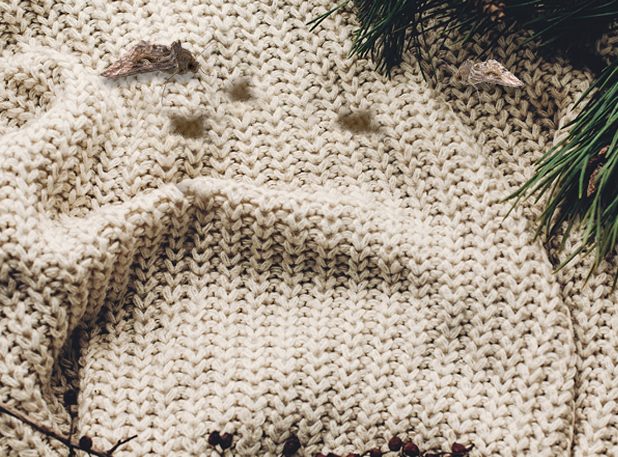Have you recently started noticing small holes in some of your favourite clothing items which you’ve put away for storage? Is this particularly happening to your woollen items?
This might be an indication that you have clothes moths living in your cupboards. Aside from the damage to your clothes, do clothes moths pose an additional risk? Will you need the services of pest control Melbourne and other Australian cities rely on?
The Low-Down on Clothes Moths
Before you know what to do about a potential clothes moth infestation, it’s important to know what they are. Since these little creatures don’t have the fearful reputation that cockroaches, termites or even ants have, they often go unnoticed. Read on to see why these critters shouldn’t be ignored!
What Are Clothes Moths?
Homeowners often confuse regular moths with clothes moths, but they’re definitely not the same. In Australia, there are two common cloth moth species.
The Tinea Pellionella commonly referred to as the Webbing Clothes Moth as well as the Tineola Bisselliella or Case-Making Clothes Moth are found all over Australia. Adult moths are long, delicate and slender looking. They’re about 6 to 10mm long.
Unlike regular moths, cloth moths aren’t attracted to light. They prefer dark areas such as your cupboards and feed on woollen fibres.
Are Clothes Moths Harmful?
There often isn’t good news related to household bugs. Fortunately, clothes moths don’t pose a health risk to humans or animals. They don’t bite and don’t transfer disease. The real threat they pose is to the clothes in your cupboard.
They favour woollen fibres especially on clothes or blankets that have been placed away for storage. Clothes that are regularly removed from the cupboards won’t have any trace of moth infestation.
Signs of Clothes Moths Infestation
Despite keeping a clean home, you might still find clothes moths in your cupboards. Unlike cockroaches and ants, clothes moths don’t scurry around in your cupboards, meaning you won’t necessarily see one if it’s in there.
So, how do you know if you have clothes moths?
- Tiny white tubes stuck to fabrics – these are larvae casings from which the baby moths will escape and start eating surrounding woollen fabrics
- Crusty deposits on clothing in the cupboard
- Silky furrows or tunnels found on woollen clothing or blankets
- Irregular holes in clothing that weren’t there before
- Tiny cream-coloured moths crawling around on surfaces
How Do You Get Rid of Clothes Moths?
If you noticed clothes moths, what’s the next step? What’s the easiest way to protect your clothes and fabrics?
- Clean & vacuum: Although your cupboards might be clean inside, it’s important to occasionally unpack them and air them out. Wash shelves and vacuum floor areas in and around the space. Clothes moths are attracted to hair or fur that can accumulate, so clean any areas where pets sleep.
- Store: Clothes moths are attracted to woollen or fur fabrics. Ensure any woollen items such as jerseys or blankets are washed and properly air dried before packing away for storage.
- Wearing & Airing: Clothes moths will find clothes you’ve put away for storage because these items haven’t been aired out. This often happens when you place winter fabrics away for summer. Make sure you periodically air out items packed away for a long period.
Is there a Natural Way to Keep Clothes Moths out of Your Cupboards?
No one wants their clothes or cupboards smelling like harsh chemicals. The good news is you can use natural essential oils to keep clothes moths out of your cupboard and home in general.
One of the scents that are known to repel moths is lavender. So, whatever option you choose, consider adding dried lavender. A few natural repellents include the following:
- Make sachets of dried lavender leaves or essential oil and suspend these little bags all over your cupboard.
- Place sachets of bay leaves mixed with dried rosemary or its essential oil in drawers after a thorough cleaning.
- If you have space in your cupboard, you can place a small open bowl with a mixture of dried lavender with eucalyptus essential oil (a few drops mixed with the dried leaves will do the trick).
- Mix a few drops of lavender oil with water and use a spray bottle to spritz carpets or inside cupboards and drawers. Don’t add too much oil to the mixture as it might damage certain types of garments. It’s better to spray the areas where you’re placing woollen clothes.
- Refresh every few weeks when the scent starts fading.
- If the natural option doesn’t seem to be helping, consult your local pest control agent to rid your home of clothes moths!
Final Thought
Don’t let clothes moths destroy your expensive clothes! Keep your cupboards clean and fresh and invest in a few essential oils or dried herbs to keep these little pests away. And call the experts to help you maintain this nasty problem.
At least your home can smell great while fighting off these critters!


